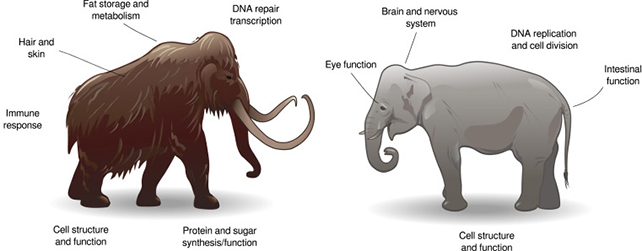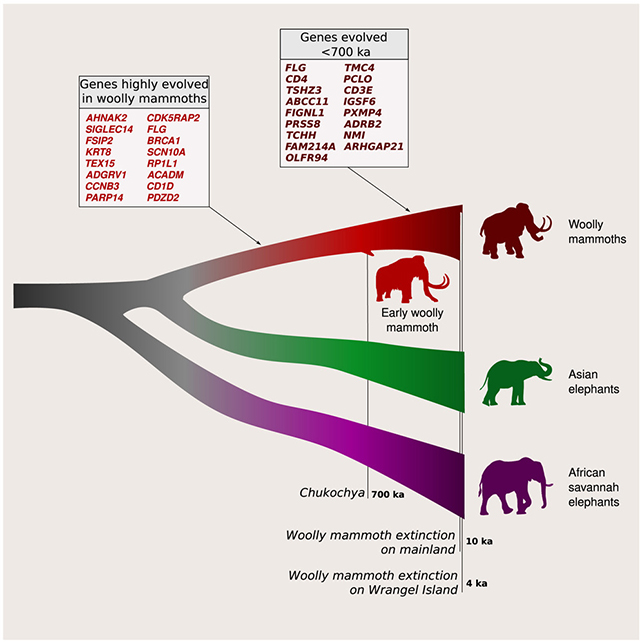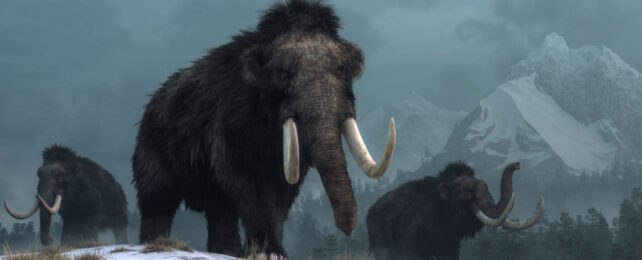As wooly mammoths grazed frigid Siberian steppes for more than half a million years, they evolved increasingly fluffy fur, large fat deposits, and smaller ears, according to a new study.
By comparing the genomes of modern elephants with those of multiple wooly mammoths – including individual mammoths that lived 600,000 years apart – researchers gained new insight into the evolution of these ice-age icons.
Distinctive features like fluffy fur and fat deposits were already genetically encoded in early wooly mammoths, the study found, but these and other characteristics seem to have grown more pronounced as the mammoths adapted to Siberia over hundreds of millennia.
"We wanted to know what makes a mammoth a wooly mammoth," says paleogeneticist and first author David Díez-del-Molino from the Center for Paleogenetics in Stockholm.
In addition to finding genetic evidence of fluffier fur and small ears, "there are also many other adaptations like fat metabolism and cold perception that are not so evident because they're at the molecular level," he adds.
A variety of mammoth species existed during the Pleistocene Epoch, probably descendants of the earlier African mammoth (Mammuthus africanavus) that migrated out of Africa.
Eurasia was long home to the steppe mammoth (M. trogontherii), for example, a likely ancestor of the more famous wooly mammoth (M. primigenius), which first appeared about 700,000 years ago in Asia.
Wooly mammoths thrived in the chilly conditions of their time, proliferating not just in Asia but also spreading around the world. They expanded into Europe and crossed the Bering Land Bridge to North America, where they eventually lived as far south as present-day Kansas.

To shed light on the genetic mutations that gave rise to wooly mammoths, Díez-del-Molino and his colleagues compared the genomes of 28 modern-day African and Asian elephants with the genomes of 23 wooly mammoths from Siberia.
Most of those mammoths were also fairly modern, at least by mammoth standards, coming from individuals that lived within the past 100,000 years or so. One specimen, however, came from the roughly 700,000-year-old Chukochya, one of the oldest known specimens of its kind.
"Having the Chukochya genome allowed us to identify a number of genes that evolved during the lifespan of the wooly mammoth as a species," says senior author and evolutionary genomicist Love Dalén, professor of evolutionary genomics at the Center for Paleogenetics.
"This allows us to study evolution in real time, and we can say these specific mutations are unique to wooly mammoths, and they didn't exist in its ancestors," he says.
Incorporating so many mammoth genomes into one study makes a big difference, the researchers say. While earlier studies have examined genomes from one or two individual mammoths, this is the first analysis with such a large sample size of mammoth genomes.
That offered a broader view, helping the researchers identify genetic mutations that were common among mammoths, and thus probably adaptive, as opposed to quirks that might have arisen in a few individuals.
"We found that some of the genes that were previously thought to be special for wooly mammoths are actually variable between mammoths, which means they probably weren't as important," Díez-del-Molino says.
The Chukochya genome shares 91.7 percent of the mutations responsible for protein-coding changes seen in more recent wooly mammoths, the study found. That suggests early wooly mammoths already had some distinctive traits when they diverged from steppe mammoths.

Yet while the first wooly mammoths may have been wooly, and possibly had other talents for which their species would later become known, those characteristics were still developing, the researchers say. They might have looked a bit different from their descendants.
"The very earliest wooly mammoths weren't fully evolved," Dalén says. "They possibly had larger ears, and their wool was different – perhaps less insulating and fluffy compared to later wooly mammoths."
Of course, evolving fluffier fur was probably adaptive in ice-age Siberia. Smaller ears would also help by reducing heat loss, as would other abilities wooly mammoths developed and refined over time.
The researchers found genes for these traits in the mammoths' genomes, and noticed similarities with unrelated animals that currently inhabit the Arctic.
"We found some highly evolved genes related to fat metabolism and storage that are also found in other Arctic species like reindeer and polar bears, which means there's probably convergent evolution for these genes in cold-adapted mammals," Díez-del-Molino says.
It remains unclear exactly why wooly mammoths suffered a "genomic meltdown" and died out several thousand years ago, although thick fur and other ice-age adaptations could have become burdens as climates warmed up, possibly compounding other threats like hunting by humans.
The study was published in Current Biology.
